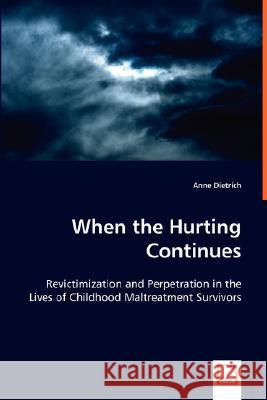When the Hurting Continues: Revictimization and Perpetration in the Lives of Childhood Maltreatment Survivors » książka
When the Hurting Continues: Revictimization and Perpetration in the Lives of Childhood Maltreatment Survivors
ISBN-13: 9783639023459 / Angielski / Miękka / 2008 / 120 str.
When the Hurting Continues: Revictimization and Perpetration in the Lives of Childhood Maltreatment Survivors
ISBN-13: 9783639023459 / Angielski / Miękka / 2008 / 120 str.
(netto: 215,74 VAT: 5%)
Najniższa cena z 30 dni: 226,53
ok. 16-18 dni roboczych
Bez gwarancji dostawy przed świętami
Darmowa dostawa!
Childhood maltreatment is a pervasive social problem with wide ranging adverse effects for many persons who survive it. A fairly consistent finding is that adults who have been hurt as children often find themselves revictimized as adults. A small proportion of adults who were hurt as children go on to harm others. Some are both revictimized and engage in perpetration. We do not know why this occurs; however, various theories have been proposed, ranging from learning theories to complex psychoanalytic ones. Empirical findings are inconsistent, and this variation may be due to differences in research methodology and operational definitions of abuse, revictimization and perpetration. In this book, Dr. Dietrich reviews the literature on revictimization and on perpetration, frames it within a theoretical model developed by Dr. Marylene Cloitre, and reports on the results of a study that examined the predictive validity of the components of the model. Dr. Dietrich proposes that there is not just one pathway to revictimization; rather, she posits several possible pathways in which individuals may find themselves in a repetitive cycle of hurt, whether from strangers or attachment figures."
Childhood maltreatment is a pervasive social problem with wide ranging adverse effects for many persons who survive it. A fairly consistent finding is that adults who have been hurt as children often find themselves revictimized as adults. A small proportion of adults who were hurt as children go on to harm others. Some are both revictimized and engage in perpetration. We do not know why this occurs; however, various theories have been proposed, ranging from learning theories to complex psychoanalytic ones. Empirical findings are inconsistent, and this variation may be due to differences in research methodology and operational definitions of abuse, revictimization and perpetration.In this book, Dr. Dietrich reviews the literature on revictimization and on perpetration, frames it within a theoretical model developed by Dr. Marylene Cloitre, and reports on the results of a study that examined the predictive validity of the components of the model. Dr. Dietrich proposes that there is not just one pathway to revictimization; rather, she posits several possible pathways in which individuals may find themselves in a repetitive cycle of hurt, whether from strangers or attachment figures.











